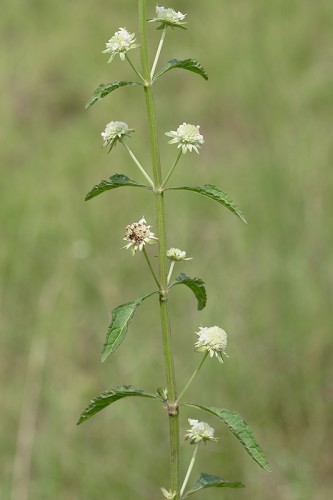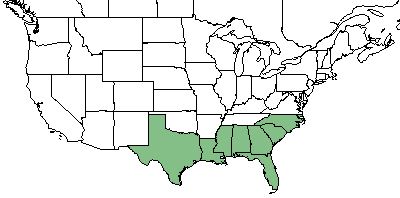Difference between revisions of "Hyptis alata"
(→Ecology) |
(→Distribution) |
||
| Line 28: | Line 28: | ||
==Distribution== | ==Distribution== | ||
| − | ''H. alata'' is specifically found in | + | ''H. alata'' is specifically found in Florida, Georgia, South Carolina, North Carolina, Alabama, Mississippi, Louisiana, and Texas in the southeastern United States. <ref name= "USDA"> [https://plants.usda.gov/core/profile?symbol=CEAM USDA Plant Database]</ref> |
==Ecology== | ==Ecology== | ||
Revision as of 20:27, 5 June 2018
Common names: clustered bushmint [1] , musky mint [2]
| Hyptis alata | |
|---|---|

| |
| Photo by the Southeastern Flora Plant Database | |
| Scientific classification | |
| Kingdom: | Plantae |
| Division: | Magnoliophyta - Flowering plants |
| Class: | Magnoliopsida - Dicots |
| Order: | Lamiales |
| Family: | Lamiaceae |
| Genus: | Hyptis |
| Species: | H. alata |
| Binomial name | |
| Hyptis alata Raf. | |

| |
| Natural range of Hyptis alata from USDA NRCS Plants Database. | |
Contents
Taxonomic Notes
Synonym: H. radiata (Willdenow)
Variety: none
Description
H. alata is a perennial forb/herb of the Lamiaceae family that is native to North America. [1]
Distribution
H. alata is specifically found in Florida, Georgia, South Carolina, North Carolina, Alabama, Mississippi, Louisiana, and Texas in the southeastern United States. [1]
Ecology
Habitat
H. alata is commonly found in wet pine savannas, edges of swamp forests, and moist ditches. [3]
Additionally, habitats that specimens of H. alata have been recovered include pine flatwoods, sandy peat of swampland, burned pineland, cypress dome, wet sandy loam, and coastal hammock. [4]
Phenology
H. alata has been known to flower in June, July, September, and October. [5]
Conservation and Management
Cultivation and restoration
Photo Gallery
References and notes
- ↑ 1.0 1.1 1.2 USDA Plant Database
- ↑ Kalmbacher, R. S., et al. (1994). "South Florida flatwoods range vegetation responses to season of deferment from grazing." Journal of Range Management 47(1): 43-47.
- ↑ Weakley, A. S. (2015). Flora of the Southern and Mid-Atlantic States. Chapel Hill, NC, University of North Carolina Herbarium.
- ↑ URL: http://herbarium.bio.fsu.edu. Last accessed: June 2018. Collectors: R.K. Godfrey, R. Kral, Samuel B. Jones, Jr., Karen MacClendon, Gary R. Knight, Loran C. Anderson. States and counties: Florida (Charlotte, Brevard, Calhoun, Jackson, Franklin), Mississippi (Lamar)
- ↑ Pan Flora